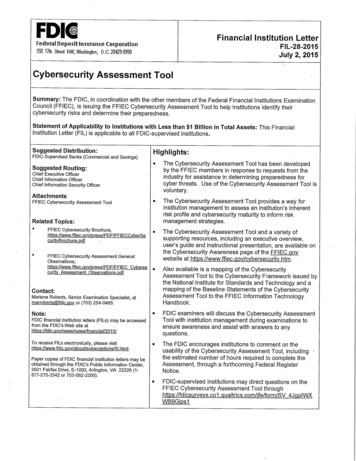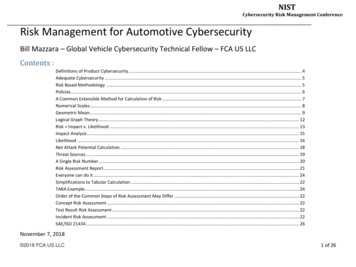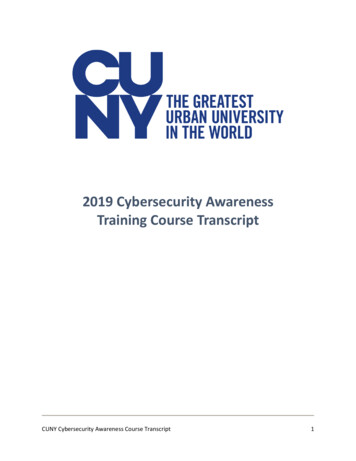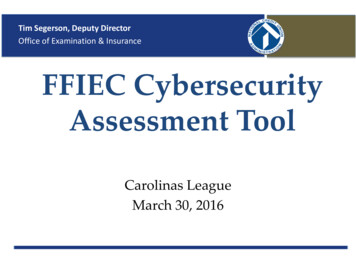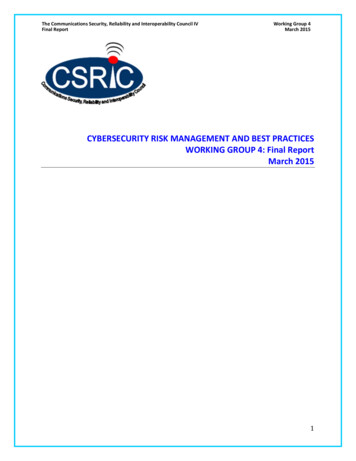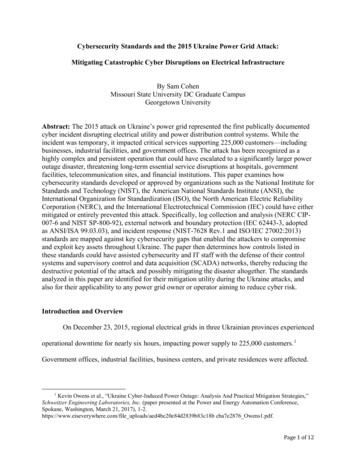
Transcription
Cybersecurity Standards and the 2015 Ukraine Power Grid Attack:Mitigating Catastrophic Cyber Disruptions on Electrical InfrastructureBy Sam CohenMissouri State University DC Graduate CampusGeorgetown UniversityAbstract: The 2015 attack on Ukraine’s power grid represented the first publically documentedcyber incident disrupting electrical utility and power distribution control systems. While theincident was temporary, it impacted critical services supporting 225,000 customers—includingbusinesses, industrial facilities, and government offices. The attack has been recognized as ahighly complex and persistent operation that could have escalated to a significantly larger poweroutage disaster, threatening long-term essential service disruptions at hospitals, governmentfacilities, telecommunication sites, and financial institutions. This paper examines howcybersecurity standards developed or approved by organizations such as the National Institute forStandards and Technology (NIST), the American National Standards Institute (ANSI), theInternational Organization for Standardization (ISO), the North American Electric ReliabilityCorporation (NERC), and the International Electrotechnical Commission (IEC) could have eithermitigated or entirely prevented this attack. Specifically, log collection and analysis (NERC CIP007-6 and NIST SP-800-92), external network and boundary protection (IEC 62443-3, adoptedas ANSI/ISA 99.03.03), and incident response (NIST-7628 Rev.1 and ISO/IEC 27002:2013)standards are mapped against key cybersecurity gaps that enabled the attackers to compromiseand exploit key assets throughout Ukraine. The paper then determines how controls listed inthese standards could have assisted cybersecurity and IT staff with the defense of their controlsystems and supervisory control and data acquisition (SCADA) networks, thereby reducing thedestructive potential of the attack and possibly mitigating the disaster altogether. The standardsanalyzed in this paper are identified for their mitigation utility during the Ukraine attacks, andalso for their applicability to any power grid owner or operator aiming to reduce cyber risk.Introduction and OverviewOn December 23, 2015, regional electrical grids in three Ukrainian provinces experiencedoperational downtime for nearly six hours, impacting power supply to 225,000 customers. 1Government offices, industrial facilities, business centers, and private residences were affected.Kevin Owens et al., “Ukraine Cyber-Induced Power Outage: Analysis And Practical Mitigation Strategies,”Schweitzer Engineering Laboratories, Inc. (paper presented at the Power and Energy Automation Conference,Spokane, Washington, March 21, 2017), 1-2.https://www.eiseverywhere.com/file uploads/aed4bc20e84d2839b83c18b cba7e2876 Owens1.pdf.1Page 1 of 12
After initial digital forensic investigations and root-cause analysis were complete, government andprivate cybersecurity stakeholders recognized that this incident was the result of a coordinated andcomprehensive cyber attack. The impact of this attack was both financially costly and strategicallysignificant, as it represented an evolution in the use of cyberspace for kinetic effects in addition toforcing Ukrainian power utilities to incur years of information technology repairs and largeinvestment in new equipment replacements.Not only are cyber threats to power grid critical infrastructure assets a core concern fornational security, but they also represent a fundamental risk to businesses and organizations thatrely on the uninterrupted daily distribution of their services—such as hospitals and waterdistribution centers requiring constant access to electricity. For example, a disruption equal to orgreater in scale than the 2015 Ukraine incident near a major urban financial center inside the U.S.could temporarily shut down banks, international business headquarters, and telecommunicationnetworks supporting money lending and transaction markets. 2 This could induce a regional ornational liquidity disaster, adversely influencing economic activity and halting money marketoperations. A 2018 International Monetary Fund report titled “Cyber Risk for the FinancialSector” reinforced this perspective, noting that, “The disruption of material infrastructures such aspower grids and IT infrastructures could also have a large macroeconomic impact. Recent studiesestimate that a disruption of part of the U.S. power grid could lead to up to USD 1 trillion inlosses.” 3 In 2017, the U.S.-based Council on Foreign Relation raised urgency to this power gridcybersecurity threat, highlighting that, “Rapid digitization combined with low levels of investment2Carolyn Cohn, “Cyber attack on U.S. power grid could cost economy 1 trillion: report,” 150708.3Antoine Bouveret, “Cyber Risk for the Financial Sector: A Framework for Quantitative Assessment,”International Monetary Fund: Working Paper Series wp.18 no. 143 (2018), 11-12.2
in cybersecurity and a weak regulatory regime suggest that the U.S. power system is asvulnerable—if not more vulnerable—to a cyberattack as systems in other parts of the world.” 4Considering the scale and potential impact a major cyber incident could pose to theelectrical grid inside the U.S. and across many other partner countries around the world, it isimportant to identify how the 2015 Ukraine incident could have either been mitigated or moreeffectively contained. This is particularly relevant as foreign and domestic threat actors—such asgovernments, hacktivists, or insider threats—continue to rapidly improve their technicalsophistication and capability to conduct sustained network exploitation activities on critical powerinfrastructure. Therefore, this paper will explore former and current power utility, smart grid, andcritical infrastructure cybersecurity standards that could have either prevented or improvedtechnical responses to the 2015 Ukraine electrical grid cyber attack.Cybersecurity Standard Implementation as a Mitigation StrategyNERC CIP-007-6 and NIST SP-800-92The Energy Policy Act of 2005 gave the Federal Energy Regulatory Commission (FERC)authority to oversee mandatory reliability standards governing the nation’s electricity grid. 5 Thisincluded authority to approve mandatory cybersecurity reliability standards ranging from technicalindustrial control system (ICS) software reviews to patch management policies for supervisorycontrol and data acquisition (SCADA) systems. The first comprehensive power grid cybersecurityRobert W. Knake, “A Cyberattack on the U.S. Power Grid,” Council on Foreign Relations: Center forPreventative Action, April 3, 2017, id.5Federal Energy Regulatory Commission Fact Sheet, “Energy Policy Act of 2005: Significant PolicyChanges,” August 8, 2006, t.pdf.43
policies—defined as Critical Infrastructure Protection (CIP) standards—were initially developedby the North American Electric Reliability Corporation (NERC) and approved by FERC in 2008. 6In March 2017, researchers from Schweitzer Engineering Laboratories, Inc., presented areport titled “Ukraine Cyber-Induced Power Outage: Analysis and Practical Mitigation Strategies”at the Power and Energy Automation Conference in Spokane, Washington. 7 The report notes thata lack of system logging and monitoring at power generation facilities contributed to the inabilityof IT and engineering teams to effectively implement an incident response plan. The report alsohighlights that this lack of logging control system network activity and the failure to establishstandard baseline system data prevented cybersecurity emergency response teams from being ableto effectively conduct root cause analysis of the cyber incident. This hindered initial investigationsand digital forensics, which created a lasting issue for precisely determining what security controlsand standards could have helped mitigate the attack. Nevertheless, recommendations from the2017 report and from a cybersecurity study produced by the Electricity Information Sharing andAnalysis Center (E-ISAC) in 2016 explicitly state that comprehensive logging and monitoring—inaddition to automated correlation—were necessary components of an effective cybersecurityposture that an electric facility relying on SCADA and ICS networks should have included. 8To mitigate the logging issue at the Ukrainian power facilities and other possible gridtargets in the U.S. or abroad in the future, cybersecurity and executive management teams couldhave implemented NERC’s CIP-007-6 Systems Security Management Standard. CIP-007-6Anastasios Arampatzi, “Revised Critical Infrastructure Protection Reliability Standard CIP–003–7: What Arethe Changes?” Trip Wire: The State of Security, September 10, 2018, -are-the-changes/.7Owens et al., “Ukraine Cyber-Induced Power Outage: Analysis And Practical Mitigation Strategies,” 1-2.8Robert M. Lee, Michael J. Assante and Tim Conway, “Analysis Of The Cyber Attack On The UkrainianPower Grid: Defense Use Case,” Electricity Information Sharing and Analysis Center, March 18, 2016, pg. 17, 21,https://ics.sans.org/media/E-ISAC SANS Ukraine DUC 5.pdf.64
security guidelines and controls aim “to manage system security by specifying select technical,operational, and procedural requirements in support of protecting Bulk Electric System (BES)Cyber Systems against compromise that could lead to misoperation or instability.” 9 This standardcalls for the implementation of log and monitoring alert systems combined with a centralizedsecurity event monitoring system where log analysis can be performed from a top-downperspective. These capabilities, mandated by the CIP-007-6 standard, would have providedcybersecurity and IT staff at the Ukrainian facilities with more awareness of their controlequipment behaviour and possibly led to the discovery of malicious cyber activity before systemswere shutdown or disrupted beyond repair.A National Institute of Standards and Technology (NIST) special publication, SP-800-92,outlines computer security standards and guidelines to “provide practical, real-world guidance ondeveloping, implementing, and maintaining effective log management practices throughout anenterprise.” 10 Use of this publication’s guidance would have provided the impacted Ukrainianfacilities and power distribution networks with a comprehensive monitoring capacity, proceduresfor automated system activity reviews, and a record of the cyber incident that could have enabledgreater root cause analysis. A 2016 industry report from the cybersecurity firm FireEye reinforcesthe role implementation of this type of standard could have played in mitigating the cyber-induceddisaster in Ukraine or a similar attack in the future, stating that, “Robust log collection andnetwork traffic monitoring are the foundational components of a defensible ICS network. Failureto perform these essential security functions prevents timely detection, pre-emptive response, and9“Programs, Departments and Standards: CIP-007-6,” North American Electric Reliability Corporation(NERC), accessed March 27, 2019, .10Computer Security Resource Center, “Guide to Computer Security Log Management,” National Institute ofStandards and Technology (NIST), last modified September 2006, /final.5
accurate incident investigation.” 11 The same year, a report from the World Energy Council alsoreinforced the role log controls listed in SP-800-92 and CIP-007-6 could have yielded during theUkraine disaster, explaining that a comprehensive log analysis program searching for “malicioussignatures could have helped detect the attack.” 12IEC 62443-3, Adopted as ANSI/ISA 99.03.03Another ICS cybersecurity standard that would have directly mitigated major aspects of the cyberattack on Ukrainian power grid facilities is IEC 62443-3. Developed by the InternationalElectrotechnical Commission (IEC) and adopted by the International Society of Automation (ISA)as the American National Standard ANSI/ISA 99.03.03, 13 this document provides a mechanismfor improving industrial automation and control system cybersecurity. ISA now works with theIEC to maintain the standard’s international implementation and to conduct continuous reviewsand updates. 14Sentryo, an industrial cybersecurity firm based in France, highlighted in their analysis ofthe 2015 Ukraine cyber attack that two key controls within the IEC 62443-3 standard—restricteddata flows (RDF) and network zone boundary protection—were not adequately met by impactedfacilities. The report notes that if RDF control 5.2 met a higher level of implementation, “theoperator could have isolated the facilities at the very first signs of the attack, which would haveIndustry Intelligence Team, “Cyber Attacks On The Ukrainian Grid: What You Should Know,” FireEye, pg.2, 2016, rid.pdf.12“World Energy Perspectives: The Road to Resilience,” World Energy Council, 2016, pg. 2016/09/20160926 Resilience Cyber Full Report WEB-1.pdf.13“ANSI/ISA-62443-3-3 (99.03.03)-2013 Security for industrial automation and control systems Part 3-3,”International Society of Automation (ISA), accessed April 7, 2019, ndsecurity-levels/116785.14“New ISA/IEC 62443 standard specifies security capabilities for control system components,” InternationalSociety of Automation (ISA), accessed April 7, 2019, https://www.isa.org/intech/201810standards/.116
stopped the attack de facto.” 15 These controls would have also increased monitoring ofcommunications at the external boundary of important ICS tools controlling power distribution,thereby raising the prospect of detecting the attacker’s use of malicious and unauthorizedcommands to turn multiple substations offline. IEC 62443-3 is another example of a technicalstandard capable of mitigating at least one key segment of the Ukraine cyber incident that enabledthe overall attack. Further, it acts as a use case for other electric enterprises aiming to improvetheir cybersecurity posture with standards to prevent future disasters.NIST-7628 Rev.1 and ISO/IEC 27002:2013NIST-7628 Revision 1, referred to as “Guidelines for Smart Grid Cybersecurity,” providesa high-level framework and standards-based recommendations for an overall smart gridcybersecurity strategy and policy architecture. 16 Certain comprised IT assets and ICS technologiesat the impacted Ukraine facilities’ relied on the smart grid digital networking approach to managepower supply provision to their customers. While these digital systems created financial andoperational efficiency benefits from a management perspective, they also created technical ITvulnerabilities that the attackers specifically leveraged. This included identifying unique gaps inorganizational incident response plans during network reconnaissance activities leading up to themain attack. 17 They aimed to ensure industrial control networks and human-machine interfaceworkstations would not be brought back online once the primary shutdown commenced—15Patrice Bock, “Analysis of cyberattack against Ukraine’s power grid on December 23, 2015,” Sentryo, July18, 2017, ne-power-grid/.16National Institute of Standards and Technology (NIST), “Guidelines for Smart Grid Cybersecurity: Volume1 - Smart Grid Cybersecurity Strategy, Architecture, and High-Level Requirements,” Department of Commerce,September 2014, pg. 146, 7628r1.pdf.17Lee, “Analysis Of The Cyber Attack On The Ukrainian Power Grid: Defense Use Case,” 5-6.7
effectively disabling the digital linkages that make a smart grid effective for oversight andoperational control.Considering incident response was a fundamental challenge that ultimately enabled thesuccess of the attack, there is a clear opportunity to apply the eleven NIST-7628 Rev.1 Smart GridIncident Response (SG.IR) controls. It is also worth noting that the controls associated withinformation security management systems (ISMS) outlined in ISO/IEC 27002:2013—a standardjointly developed by the International Organization for Standardization (ISO) and the IEC—canprovide similar useful incident response guidelines. For example, like the NIST-7628 Rev.1guidelines, ISO/IEC 27002:2013 suggests the development and thorough testing of reporting,forensic incident collection, business continuity, and event analysis procedures. 18The previously mentioned 2016 E-ISAC study suggests that the Ukrainian networkdefenders at the facilities needed to “develop anticipatory responses to attack effects” and to addroutine audits to “examine their detection and response capabilities.” 19 During the powershutdown, attackers targeted server and computer uninterruptable power backup supplies (UPS) toensure operators and IT staff could not conduct their established incident response procedures.The attackers also conducted a Telephony Denial of Service (TDoS) operation to disrupt thecommunications between in-house staff, external private firms, and government offices working tomitigate the attack. 20 This operation leveraged the same tactics of a Distributed DoS attack onnetwork or application servers but aimed to overload the phone systems to disrupt emergencyresponse coordination. Using the 11 NIST-7628 Rev.1 SG.IR controls, Ukrainian grid18Eric Lachapelle and Mustafe Bislimi, “Whitepaper: ISO/IEC 27002:2013 Information Technology andSecurity Techniques,” ZIH and Professional Evaluation and Certification Board (PECB), February 26, 2016, pg. 910, iso27002.pdf.19Ibid., 15-16.20Owens et al., “Ukraine Cyber-Induced Power Outage: Analysis And Practical Mitigation Strategies,” 1.8
cybersecurity teams would have had well-defined roles and responsibilities; tested response plans;outlined incident handling, monitoring, and reporting requirements; established incidentinvestigation and analysis plans; and pre-designated system backup and emergencycommunication procedures. 21 According to the E-ISAC report, these capabilities could havedirectly identified the need for secondary capabilities at telecommunication sites to offset an activeTDoS attack or the need to disable remote interactive functionality with field devices connected toSCADA grid information systems—a security gap the attackers used to shutdown electricitysubstations while masking themselves as authentic users. Therefore, use of the NIST-7628 Rev.1controls—layered with the ISO/IEC 27002:2013 guidelines—would have directly provided ahigher degree of cyber resiliency for power enterprises who suffered outages during the attack.ConclusionLeveraging the cybersecurity standards and guidelines listed in this paper would havedirectly influenced the sequence of events during the 2015 Ukraine cyber attack, either providingUkrainian cybersecurity and IT staff with additional functional control over their systems or theability to deny the attackers an initiative altogether. While the direct impact of the Ukraineincident was limited in terms of being a prolonged national disaster, the attack reinforced growingconcerns that strategic IT threats to national power grid systems exist—and that certain actors aretechnically capable of exploiting their vulnerabilities. Private and public critical infrastructurestakeholders operating within the power grid, especially those rolling out new IT systems forsmart grid operations, need to recognize cybersecurity standards as a financially and operationallyfeasible countermeasure to power grid and utility cyber risk. In doing so, a catastrophic cyberNational Institute of Standards and Technology (NIST), “Guidelines for Smart Grid Cybersecurity: Volume1 - Smart Grid Cybersecurity Strategy, Architecture, and High-Level Requirements,” 146.219
disaster in the future will likely be mitigated or even prevented, just as it would have been inUkraine.10
BibliographyArampatzi, Anastasios. “Revised Critical Infrastructure Protection Reliability Standard CIP–003–7: What Are the Changes?” Trip Wire: The State of Security. September 10, 7-what-are-the-changes/.Bock, Patrice. “Analysis of cyberattack against Ukraine’s power grid on December 23, 2015.”Sentryo. July 18, 2017. ne-power-grid/.Bouveret, Antoine. “Cyber Risk for the Financial Sector: A Framework for QuantitativeAssessment.” International Monetary Fund: Working Paper Series wp.18 no. 143 (2018), 128.Cohn, Carolyn. “Cyber attack on U.S. power grid could cost economy 1 trillion: report.”Reuters. omputer Security Resource Center. “Guide to Computer Security Log Management.” NationalInstitute of Standards and Technology (NIST). Last modified September 800-92/final.Federal Energy Regulatory Commission (FERC). “Cyber and Grid Security.” Last modifiedApril 2019. /reliability/cybersecurity.asp.Industry Intelligence Team. “Cyber Attacks On The Ukrainian Grid: What You Should Know.”FireEye. 2016. rid.pdf.International Society of Automation (ISA). “ANSI/ISA-62443-3-3 (99.03.03)-2013 Security forindustrial automation and control systems Part 3-3.” Accessed April 7, nts-and-securitylevels/116785.International Society of Automation (ISA). “New ISA/IEC 62443 standard specifies securitycapabilities for control system components.” Accessed April 7, nake, Robert W. “A Cyberattack on the U.S. Power Grid.” Council on Foreign Relations:Center for Preventative Action. April 3, 2017. d.Lachapelle, Eric and Mustafe Bislimi. “Whitepaper: ISO/IEC 27002:2013 InformationTechnology and Security Techniques.” ZIH and Professional Evaluation and Certification11
Board (PECB). February 26, 2016. so27002.pdf.Lee, Robert M., Michael J. Assante and Tim Conway. “Analysis Of The Cyber Attack On TheUkrainian Power Grid: Defense Use Case.” Electricity Information Sharing and AnalysisCenter. March 18, 2016. https://ics.sans.org/media/E-ISAC SANS Ukraine DUC 5.pdf.National Institute of Standards and Technology (NIST). “Guidelines for Smart GridCybersecurity: Volume 1 - Smart Grid Cybersecurity Strategy, Architecture, and High-LevelRequirements.” Department of Commerce. September T.IR.7628r1.pdf.North American Electric Reliability Corporation (NERC). “Programs, Departments andStandards: CIP-007-6.” Accessed March 27, .aspx.Owens, Kevin, David E. Whitehead, Dennis Gammel, and Jess Smith. “Ukraine Cyber-InducedPower Outage: Analysis And Practical Mitigation Strategies.” Schweitzer EngineeringLaboratories, Inc. Paper presented at the Power and Energy Automation Conference,Spokane, Washington, March 21, 2017.https://www.eiseverywhere.com/file uploads/aed4bc20e84d2839b83c18bcba7e2876 Owens1.pdf.World Energy Council. “World Energy Perspectives: The Road to Resilience.” s/2016/09/20160926 ResilienceCyber Full Report WEB-1.pdf.12
sophistication and capability to conduct sustained network exploitation activities on critical power infrastructure . Therefore, th is paper will explore former and current power utility, smart grid, and critical infrastructure cybersecurity standards th at could have either prevented or improved


